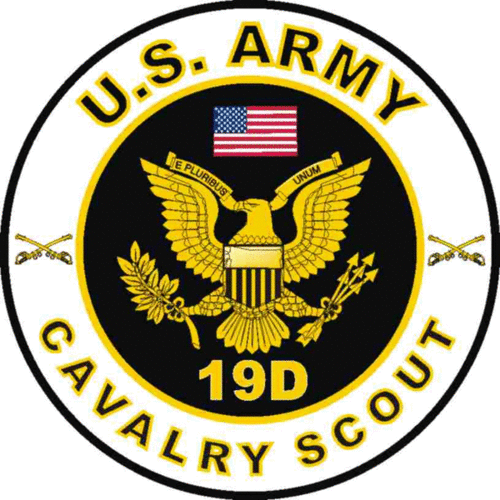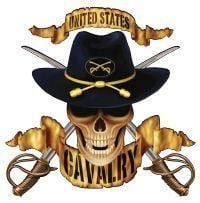Country United States | ||
 | ||
Active 17 November 1775–present Allegiance United States of America Type Main Armor Corps Element Role Reconnaissance, security, assault | ||
The Cavalry Scout is a job title and a reconnaissance specialist in the United States Army. Cavalry Scouts work to obtain, distribute, and share vital combat and battlefield information on the enemy and on combat circumstances and environmental conditions. The role originated with the United States Cavalry. The Cavalry Scout is also known as the "eyes and ears" of the Army.
Contents
- Major Duties by Skill Level
- Uniform
- Qualifications
- Additional skill identifiers
- Skill qualification identifiers
- Training and School information
- Notable cavalry scouts
- References

The Cavalry Scout is the commander's eyes and ears on the battlefield. When information about the enemy is needed, they call on the Scouts. Cavalry Scouts gather information by dismounted and/or mounted reconnaissance patrols. They are responsible for reconnaissance and they utilize various weapons to include explosives and mines. Cavalry Scouts engage the enemy with anti-armor weapons and scout vehicles in the field, track and report enemy movement and activities, and will direct the employment of various weapon systems onto the enemy. The job of a Cavalry Scout is to operate as one of the first personnel in an area, provide forward reconnaissance and spotting for the U.S. Army, and find and relay key information about the enemy to commanders and leaders in the field. Their duties include assisting with observation and listening posts, gathering reconnaissance information, performing and helping with navigation, and helping secure and transport ammunition. The Cavalry Scout leads, serves, or assists as a member of scout crew, squad, section, or platoon in reconnaissance, security, and other combat operations.

Major Duties by Skill Level
Skill Level I (E1 Private - E4 Specialist/Corporal)

Skill Level II (E5 Sergeant)

Skill Level III (E6 Staff Sergeant)

Skill Level IV (E7 Sergeant First Class)

Uniform
Cavalry Scouts wear the ACU, or Army Combat Uniform. The standard camouflage pattern issued is the UCP (Universal Camouflage Pattern), or in certain theatres (specifically soldiers going to, or coming from Afghanistan), the OCP (OEF) Camouflage Pattern, commonly referred to as Multicam. Two unique articles, the stetson hat as well as spurs, can be worn during special events or when directed by the chain of command. Cavalry Scouts are permitted to wear the Cavalry Stetson Hat with the Dress Uniforms during formal unit functions. The Stetson is traditionally accompanied by wearing the spurs which are earned when the unit conducts a "Spur Ride." Cavalry Spurs can be earned by all Cavalry Scouts. Spurs may be worn on bloused combat boots with the dress uniforms and the duty uniform. The generally accepted Cavalry Spurs are the simplified Prince of Wales spurs (spurs without the rowel, or star-shaped 'wheel' on the back).
A Scout is authorized to wear silver spurs if he has completed a Spur Ride, a rigorous series of physical and mental tasks/events designed to test the scout's military skills, military bearing, physical endurance, mental fortitude, teamwork, ability to act under pressure and exhaustion, and ability to think and improvise quickly. The spur ride was similar to the Infantry's EIB in that only a scout could earn them. That tradition has since changed from the mid to late 90's and now anyone serving in a Cavalry unit, CA or CSS can earn them. The Spur Ride rarely lasts more than three days (sometimes as little as one very long day and night), primarily due to U.S. Army regulations against hazing traditions. In short, it once was a "gut" check or a "smoke" session but it has changed with the times but some units still practice some of the older traditions when it comes to earning the spurs. The exact details of a Spur Ride varies according to the traditions of the particular Cavalry Squadron.
A Scout who has previously earned his silver spurs and then serves in combat is eligible for brass or gold combat spurs. Scouts who have directly been involved in combat are often awarded combat spurs in lieu of the normally prerequisite silver spurs.
The Certificate awarded to Order of the Spur inductees, while honored by Cavalrymen everywhere, is not a document that is authorized for inclusion in a soldier's permanent official military file. Regardless, induction into the Order of the Spur is for life, and once awarded is recognized no matter which duty station the Cavalry Scout is assigned to.
Although awarding of the Cavalry Spurs is often reserved for Cavalry troopers only, a deserving soldier or foreign military member who has provided great service (often in combat) to the Cavalry Squadron may be awarded Spurs.
The spurs and stetson are not authorized and are not official headgear or award. They are part of the esprit de corps that lives within the Cav.
Qualifications
Physical demands rating and qualifications for initial award of MOS; the job is available to female personnel. Cavalry scouts must possess the following qualifications:
Additional skill identifiers
Skill qualification identifiers
Training and School information
All Cavalry Scouts attend OSUT (One Station Unit Training) at Fort Benning in Georgia. The first phase, roughly 9 weeks, is basic military training. The second phase, roughly 7 weeks long, focuses on becoming a Scout for a total of 16 weeks. During these final weeks the future Cavalry men are trained by Instructors as well as their Drill Sergeants.
The OSUT training was moved from Fort Knox, Kentucky, to Fort Benning, Georgia, in 2011.
Training is broken into color-coded phases, during which recruits gain increasing freedom, based on the recommendations of their drill instructors. Training requires good physical and mental condition, and is mostly hands on, in the field.
